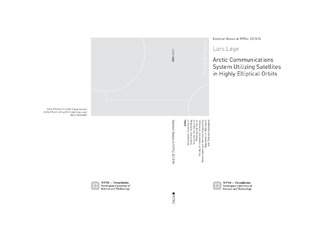| dc.contributor.advisor | Gutteberg, Odd | nb_NO |
| dc.contributor.author | Løge, Lars | nb_NO |
| dc.date.accessioned | 2014-12-19T13:48:19Z | |
| dc.date.accessioned | 2015-12-22T11:47:50Z | |
| dc.date.available | 2014-12-19T13:48:19Z | |
| dc.date.available | 2015-12-22T11:47:50Z | |
| dc.date.created | 2013-03-18 | nb_NO |
| dc.date.issued | 2013 | nb_NO |
| dc.identifier | 611689 | nb_NO |
| dc.identifier.isbn | 978-82-471-4289-9 | nb_NO |
| dc.identifier.isbn | 978-82-471-4290-5 | |
| dc.identifier.uri | http://hdl.handle.net/11250/2370683 | |
| dc.description.abstract | Activities in the Arctic and high latitude regions are increasing, and this trend will likely continue in the future. A higher activity level will generate an increasing demand for communications services. Several studies have concluded that there are already unsatisfied demands for communications services in the Arctic. Adequate system solutions must be developed to meet current and future communications requirements. This thesis addresses this issue and proposes a satellite system that can provide reliable communications services with high availability to the Arctic. The Arctic service requirements are discussed and quantified, and a gap analysis identifies the coverage requirements. Satellite orbits, which can provide the required coverage, are subsequently considered with a focus on HEO alternatives. Four promising options are identified with orbital periods of close to 12 h, 16 h, 18 h and 24 h. The effect of a non-critical inclination has been investigated, and an inclination higher than 63.4° is a realistic option only with a 24 h orbit. Fifteen constellation alternatives were defined following consideration of eccentricity effects. They were then evaluated on eight key performance properties where the 12 h and 16 h alternatives were found to be superior. A 12 h alternative was best rated, but the radiation environment and stationkeeping performance are better with 16 h orbits compared to 12 h orbits. However, it is assumed possible to mitigate these effects, and a constellation with three satellites in 12 h orbits was selected as a base case. Frequency alternatives are discussed, and propagation effects are considered for the Ku and Ka bands. System architecture and payload design are also considered along with crucial issues such as coding and modulation, Doppler shift and satellite handover. Link budgets are analyzed based on the resulting system parameters, and design and performance of possible earth stations are presented. The proposed HEO based solution can provide services to the Arctic with a performance level similar to what GEO systems provide elsewhere. The thesis also considers satellite dimensioning and offer rough order of magnitude cost estimates for the proposed space segment. | nb_NO |
| dc.language | eng | nb_NO |
| dc.publisher | NTNU | nb_NO |
| dc.relation.ispartofseries | Doctoral Theses at NTNU, 1503-8181; 2013:96 | nb_NO |
| dc.relation.haspart | Løge, Lars; Gangås, Odd. Migrating Communications Services Towards Ka-band - From Trends to Focused Development. Proceedings of AIAA SPACE 2011 Conference & Exposition, 2011. 10.2514/6.2011-8058. | nb_NO |
| dc.relation.haspart | Løge, Lars. Assessment of Satellite Constellations for Arctic Broadband Communications. Proceedings of the 29th AIAA International Communications Satellite Systems Conference, 2011. 10.2514/6.2011-8058. | |
| dc.relation.haspart | Løge, Lars. Parametric Evaluation of HEO Constellations Supporting Communications to the Arctic. Proceedings of the 30th AIAA International Communications Satellite Systems Conference, 2012. | |
| dc.subject | Satellite Communications | en_GB |
| dc.subject | Highly Elliptical Orbits | |
| dc.subject | Broadband Communications | |
| dc.title | Arctic Communications System Utilizing Satellites in Highly Elliptical Orbits | nb_NO |
| dc.type | Doctoral thesis | nb_NO |
| dc.source.pagenumber | 285 | nb_NO |
| dc.contributor.department | Norges teknisk-naturvitenskapelige universitet, Fakultet for informasjonsteknologi, matematikk og elektroteknikk, Institutt for elektronikk og telekommunikasjon | nb_NO |
| dc.description.degree | PhD i elektronikk og telekommunikasjon | nb_NO |
| dc.description.degree | PhD in Electronics and Telecommunication | |

